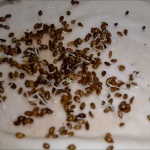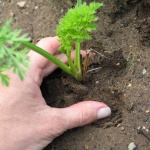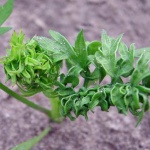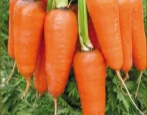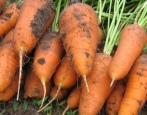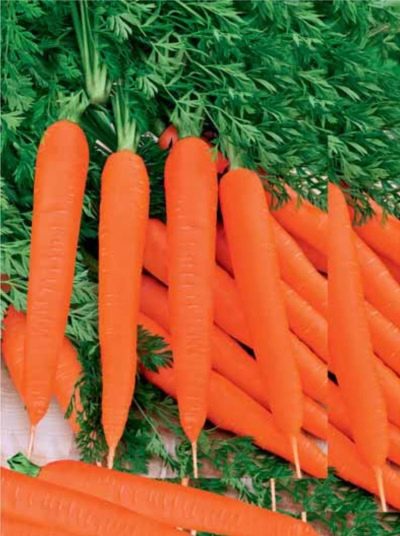
- Authors: Nastenko N.V., Kachainik V.G., Gulkin M.N.
- Year of approval: 2015
- Appointment: for fresh consumption, for canning, for freezing, for making juice
- Leaf rosette shape: from semi-spreading to spreading
- Leaves: very long, dark green, moderately dissected
- Weight, g: 100-164
- The form : elongated-conical with a weak taper and a slightly tapered base
- Taste qualities: good and excellent
- Composition : dry matter - 11.4-15.8%, total sugar - 7.0-8.8%, carotene - up to 12.0 mg per 100 g of raw matter
- Ripening terms: mid-season
There are a great many types of carrots today. Among those that have gained considerable popularity, the Red Giant carrot. Farmers often choose this variety for picky care and decent yields.
Breeding history
The variety in question appeared thanks to the Moscow agronomic firm "Aelita". Such breeders as V.G. Kachainik, N.V. Nastenko, M.N.Gulkin worked on it. In 2015, the vegetable was added to the list of the State Register and was admitted to mass cultivation.
Description of the variety
This crop does not belong to the category of hybrids, it is an independent variety belonging to the Flakke variety type.
Characteristics of the appearance of the plant and root crops
In shape, the rosette of a vegetable can be spreading or semi-spreading. The deep green oblong leaves have split edges. The root crop repeats in shape an elongated cone with a pointed base. In length, the carrot stretches by about 25 centimeters, its core is small, the skin is smooth. Each specimen weighs 100-164 grams and reaches 4.5-6 centimeters in diameter. The coloration of the Red Giant lives up to the name, it is red-orange. In terms of consistency, the pulp is juicy. Carrots collected from the beds are stored without problems throughout the winter and retain their presentation for a long time, which is important when selling them.
Purpose and taste of tubers
The red giant is versatile, carrots can not only be eaten directly from the garden, grated into salads, soups, baked goods, turned into puree and juice, but also frozen and canned. The vegetable exhibits excellent taste - it is sweet, with a pleasant crunch. In addition, the root vegetable enriches the human body with vitamins, it contains a lot of carotene.
Maturation
Experts classify the culture as mid-season. The harvest period for ripe vegetables begins 100-120 days after planting.
Yield
The described variety boasts high productivity. On average, a farmer can count on 284-355 centners per hectare.
Growing regions
Officially, this variety was created for cultivation in the Central region of our country, but in reality the geography of its distribution has expanded, now this species can be observed in the garden of almost any locality in Russia.
Growing and care
Preparing the seeds for sowing, they are disinfected with potassium permanganate and germinated within a week, wrapped in a piece of damp cloth. Germinated planting material is sown into the soil at the end of April. For this, grooves with a depth of about one and a half centimeters are arranged in the ground. The recommended row spacing is 18-20 centimeters.
After the formation of seedlings, the carrots are irrigated twice a week, always with warm water, in the evening or morning. Regularly, the garden bed is freed from weeds, and the shoots are thinned out.The vegetable loves to be pampered with top dressing. Urea, superphosphate, potassium nitrate can play its role. Harvesting ripe vegetables should be started at the moment when the lower leaves of the tops turn yellow.
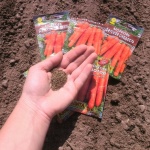
Carrots are one of the most unpretentious crops in terms of growing conditions; they can endure a short drought and a short cold snap. However, to get tasty and large root crops, you should adhere to the basic rules for planting carrots.


Soil requirements
The red giant feels good in the loose earth, which easily allows oxygen and moisture to pass through itself. Preference should be given to suspended or loamy soil.
Required climatic conditions
When deciding on a place for a garden, experts advise paying attention to an area open to sunlight, or in partial shade.
Disease and pest resistance
The culture in question shows high resistance to some ailments, for example, to cracking of root crops and flowering. However, if the rules of care are violated, it can get sick with dry, black or white rot, and be attacked by a wireworm.
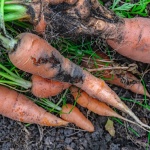
Carrots grow in almost any garden. There is an opinion that this culture is very resistant to all kinds of diseases and pests, but this is not the case. Without proper care, carrots become susceptible to all kinds of infections and are affected by harmful insects.
Review overview
Novice summer residents, along with experienced farmers, speak of the above-described variety in the best possible way. They note that caring for the Red Giant does not require much effort, the vegetables are sweet, even, voluminous.


